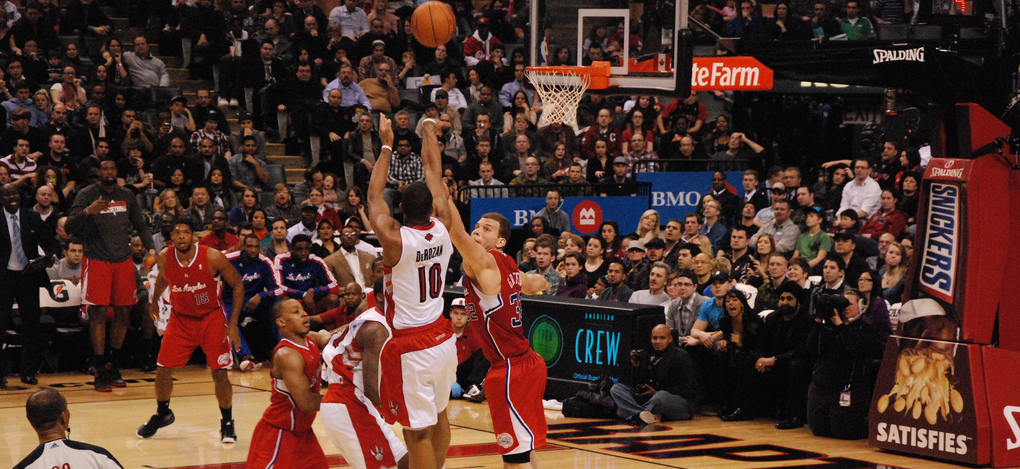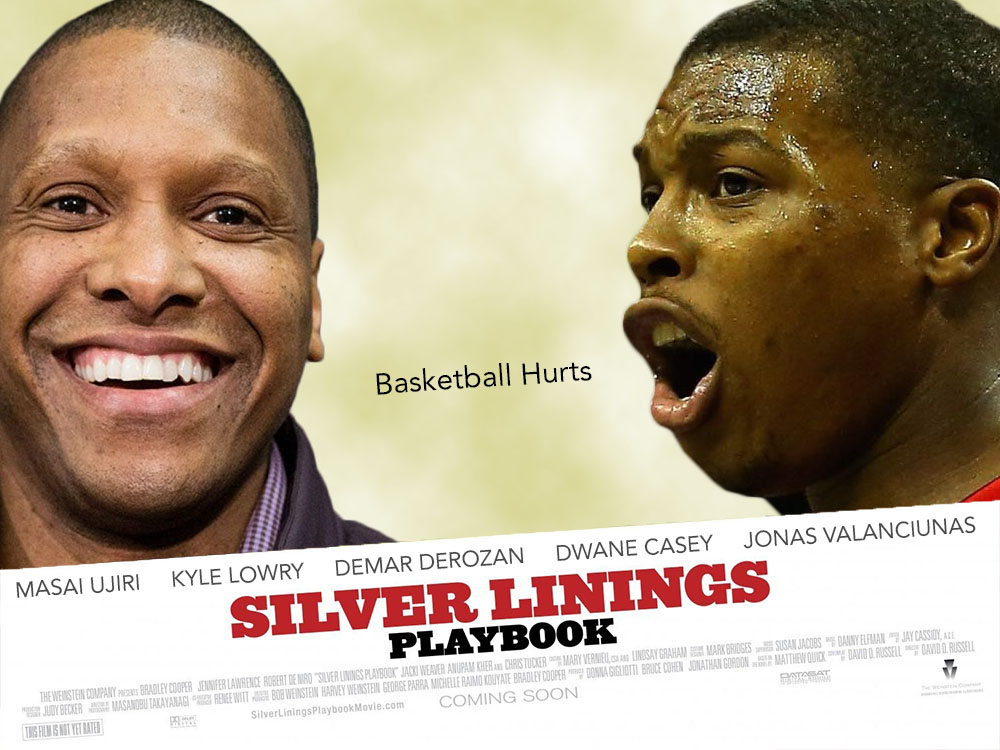Believe it or not, the humiliating sweep the Raptors experienced was probably the best thing for this franchise. The worst thing would have been for a competitive series against a Washington team that still has plenty of work to do themselves (starting with getting a new coach). A competitive series might have simply masked the inadequacies of the roster and had the same effect that the winning streak after the Rudy Gay did; delayed the inevitable. Again.
Grantland’s venerable Zach Low did a breakdown of the winners and losers of the playoffs and included a few rather scathing paragraphs about the Raptors, including this bit:
We know what the Raptors are now: a cute regular-season team that can no longer sustain strong two-way play, and that followed up two Atlantic Division titles — hang those banners next to the Bon Jovi one! — with exactly zero playoff series wins. Masai Ujiri knows, too, and he always suspected; he admitted to me in December that the Raps’ ascension within a weak Eastern Conference might be fool’s gold, and he wisely resisted win-now moves at the trade deadline.
Raptor fans hate when American reporters bash their team, but it’s hard to argue with him on this one. And if Ujiri had a suspicion in December that the team was not nearly as good as their record, it should have been confirmed by the trade deadline after coming back to earth in January. One might wonder why he didn’t try and turn someone like Lou Williams or Amir Johnson and their expiring contracts into something of value instead of losing them for nothing or overpaying them to stay.
But this isn’t about what Ujiri could or could not have done. It’s about what has been done and what should be done.
While fans, writers and even management can make all kinds of excuses, this team was not built or designed to succeed, especially in the playoffs.
The NBA is always evolving not just on the court but off it. That keeps things interesting, but also makes it a challenge to plan too far ahead. At one time, having a bruising power forward who would stay in the paint was the norm. Now, Draymond Green is projected to make eight figures because he’s a power forward who can step out and hit the three while guarding multiple positions.

Spacing has become more and more important as defenses get more and more sophisticated and players become longer and quicker. Players who can’t hit the three are becoming obsolete. Amir Johnson knew it, which is why he kept working on extending his range until he became a 40% three point shooter this year, the only real one on the team1. Of course, the time it took him to actually shoot the ball meant the ball couldn’t really be swung to him for a three within the offense. He would generally only shoot it if his man dared him to. [aside]1. Landry Fields’ 1 for 2 or Bruno Coboclo’s 2 for 3 from three don’t count.[/aside]
Amir had to extend his jumpshot in order to be able to play with Jonas Valanciunas and not completely kill the team’s spacing. The problem is that moving Amir away from the basket took him away from what he does best, grab offensive rebounds and score around the basket. The spacing was much better with Patrick Patterson, who is a much better (and quicker) three point shooter, but the defense suffered when both he and Valanciunas were on the court together. Patterson has his strengths, but he doesn’t have the defensive impact Amir does, although Amir’s failing body is lessening the difference, but not in a good way.
The Spurs are successful with two traditional big men, in Tim Duncan and Tiago Splitter, but they won the Championship last year due in large part to the play of Boris Diaw, an older, slower version of Draymond Green. Splitter played less and less as the playoffs went on in favour of Diaw who ended up averaging more minutes in the playoffs than the offensively limited Splitter.
To make matters worse, for the Raptors’ spacing, DeMar DeRozan is a lot of things but a good three point shooter is not one of them. He’s a career .275 shooter from beyond the arc and shot only slightly above that this season. He’ll go through short periods where he’ll shoot well (he shot a respectable .375 from three in the playoff series against Washington), but on the whole he’s not consistent enough to stretch the defense and create space for his teammates.

DeRozan’s biggest problem is he’s simply not a modern shooting guard. He can’t shoot from outside and his offense consists of isolations and postups. Add the fact that he’s still a negative on defense, and you’ve got a player difficult to fit into a winning system. And playing with a paint-bound Valanciunas, who simply isn’t good enough to cover his mistakes on defense, is not exactly a recipe for success. Worst of all, he’s simply not an efficient scorer, despite getting to the line at a high rate, in large part due to his willingness to force shots he shouldn’t.
DeRozan is a hard worker and wants desperately to win, but his flaws make that a difficult proposition, especially if he’s expected to be your first or second option. The Raptors have tried to force an offense around a player who wasn’t worthy in the past, and it didn’t end well. We saw in the playoffs against Washington the problems with relying too heavily on DeRozan.
It is true that Dwane Casey is partly to blame for not being able to come up with a better offensive scheme to take advantage of DeRozan’s strengths and hide his weaknesses, but the best NBA offenses today rely on perimeter players who can stretch the defense and move well without the ball, neither of which are strengths of DeRozan.
Speaking of Casey, there seems to be a line of thinking among many fans that replacing him with a better coach and changing a few pieces is all the team really needs2, but that continues to ignore the flaws and limitations of the core of the team. And it goes beyond DeRozan, Amir and Valanciunas.

[aside]2. A common refrain among fans, now and in the past, is to get a “name” coach, as if that will solve the problems of the roster. Stan Van Gundy couldn’t overcome Detroit’s poorly constructed roster, and even waiving Josh Smith couldn’t make them a .500 team. Sacramento’s record was relatively similar before and after George Karl was hired. There are some coaches that do better with less talent and some coaches do better with more, but few coaches do well with a flawed roster that doesn’t fit well together.[/aside]
Acquiring Kyle Lowry, three years ago, was a bit of a gamble considering his checkered past and physical limitations (he’s a little small and not super quick). After a bit of a rocky start, he eventually became the emotional leader of the team and the main reason for their early success this year. His decline mirrored the team’s and showed just how important he was to the team’s success.
And that’s the problem.
In his nine year NBA career, Kyle Lowry has not been able to play consistently well over one entire season. His best overall season was last year, but he struggled early which may have cost him his first All Star selection. While he made it this year, it was solely based on his early play because he often looked like a below average starter after the All Star break.
It’s true he may have been struggling with injuries, but this shouldn’t be a surprise. His style of play and the fact that he’s not always been the most dedicated at keeping his body in shape means injuries are going to be the norm. The fact that he also just turned 29 should also be a bit a concern. Some players can play well into their 30s, but slower, undersized point guards who aren’t always in the best shape tend to go downhill pretty fast past 30 (Deron Williams is just a year older than Lowry).
This goes beyond just the physical, though. One of Lowry’s great strengths is that he plays with a chip on his shoulder, but that’s also one of his biggest weaknesses. Lowry thinks he’s Chris Paul, but he’s not. While his ferocity and arrogance can often help a team, his tendency to try to do too much and take bad shots is only one of the reasons he’s apparently been at odds with just about every coach he’s had, including Casey.

One of the most important things a point guard needs to do is make good decisions, and when you let your emotions get the better of you, that often doesn’t happen. Lowry actually has a good assist to turnover ratio, but where he struggles with his decision making is shooting the ball and on defense. Lowry’s a career .417 shooter and too often falls in love with the long ball. While he did show he could be a positive on defense last year, his gambling during the Washington series was a good example of how much he can hurt the team defensively.
I recently had a discussion with someone on Twitter who felt that because Lowry, DeRozan and Valanciunas were above average starters, that was good enough reason to keep them. But if there is one thing that Raptor fans have learned over the years it’s that a player’s importance isn’t measured by how “talented” he is. Rudy Gay was the most talented player on the Raptors’ roster since Chris Bosh, but the team played better without him.
Building a great team is not always about getting the best players but the right ones. And it’s hard to argue that the Raptors currently have the right ones. The silver lining is that Ujiri should now be compelled to do something about it.



